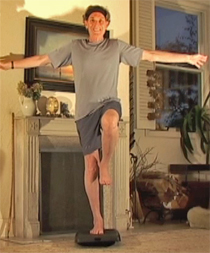Competitive athletes spend hundreds of hours each year working to improve their balance – because other professional athletes are trying to knock them down, or because they move so fast the slightest imbalance and down they go.
Older folks like me should fear falling because, get this: of the 300,000 men and women over 65 who fracture a hip this year, 20% will die within a year. And 50% won’t regain their mobility; they’ll move to nursing homes.
You, like everybody, could slip, trip or otherwise sprain an ankle or end up on your butt later today. And off both your feet for six to eight weeks. Not to mention the pain.
Or you can buy a Balance Board for less than $20. That’s less than the co-pay in the emergency room.
Three minutes a day on your balance board will do the trick; five or ten minutes is better. You’re too busy? C’mon, wake up and stand on your balance board for the first three minutes you check your e-mail. Really, you can do that. Personally, I’m not big on that kind of multi-tasking. But it beats a sprained ankle.
How the balance board works
The board doesn’t balance you; you balance you. The board’s bottom isn’t flat; it’s curved. So when you stand on it, it’s almost surely going to tip to one side or the other. The object of the game is to balance yourself and the board by perfectly centering your weight on the absolute center of the board. Which really isn’t that hard; do it a few times and you’ll be an expert. In the first few seconds, you’ll feel dozens of small muscles in your calves, ankles and feet working to make the fine adjustments. And you’ll feel your hip muscles working overtime when you bring your knee up to knee lift position.
You’ll use all your core muscles, too – especially your abs – to maintain your center of balance. It’s a great way to exercise. The less you move, the better you’re doing.
1-Leg Stand with Knee Lift exercise on Balance Board
Exercising with a balance board strengthens many of the dozens of muscles you use reflexively to regain your balance at the moment you sense you’re about to fall. And it trains those muscles to react fast. It’s actually fun – kind of like being on a tiny surfboard. After a couple of weeks of training, you’ll feel the difference every time you step onto an uneven surface, a slippery surface or anything unstable.
Height-Adjustable Balance Board, $20.
